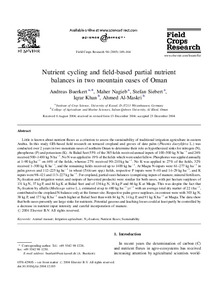| dcterms.abstract | Little is known about nutrient fluxes as a criterion to assess the sustainability of traditional irrigation agriculture in eastern Arabia. In this study GIS-based field research on terraced cropland and groves of date palm (Phoenix dactylifera L.) was conducted over 2 years in two mountain oases of northern Oman to determine their role as hypothesized sinks for nitrogen (N), phosphorus (P) and potassium (K). At Balad Seet 55% of the 385 fields received annual inputs of 100–500 kg N ha^-1 and 26% received 500–1400 kg N ha^-1. No N was applied to 19% of the fields which were under fallow. Phosphorus was applied annually at 1–90 kg ha^-1 on 46% of the fields, whereas 27% received 90–210 kg ha^-1. No K was applied to 27% of the fields, 32% received 1–300 kg K ha^-1, and the remaining fields received up to 1400 kg ha^-1. At Maqta N-inputs were 61–277 kg ha^-1 in palm groves and 112–225 kg ha^-1 in wheat (Triticum spp.) fields, respective P inputs were 9–40 and 14–29 kg ha^-1, and K inputs were 98–421 and 113–227 kg ha^-1. For cropland, partial oasis balances (comprising inputs of manure, mineral fertilizers, N2-fixation and irrigation water, and outputs of harvested products) were similar for both oases, with per hectare surpluses of 131 kg N, 37 kg P, and 84 kg K at Balad Seet and of 136 kg N, 16 kg P and 66 kg K at Maqta. This was despite the fact that N2-fixation by alfalfa (Medicago sativa L.), estimated at up to 480 kg ha^-1 yr^-1 with an average total dry matter of 22 t ha^-1, contributed to the cropland N-balance only at the former site. Respective palm grove surpluses, in contrast were with 303 kg N, 38 kg P, and 173 kg K ha^-1 much higher at Balad Seet than with 84 kg N, 14 kg P, and 91 kg K ha^-1 at Maqta. The data show that both oases presently are large sinks for nutrients. Potential gaseous and leaching losses could at least partly be controlled by a decrease in nutrient input intensity and careful incorporation of manure. | eng |

